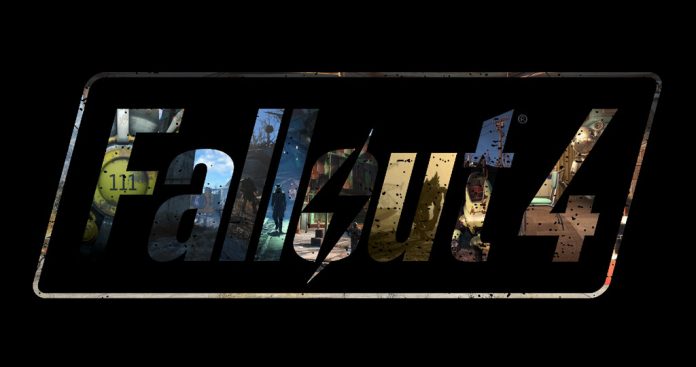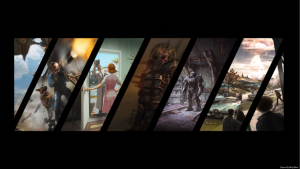There are spoilers in this review, you have been warned.
There is certainly a unique aesthetic and feel to nearly all of the games developed by Bethesda Game Studios. They have a phenomenal record and pedigree for creating games that exhibit all of the key elements needed for a successful open world role playing game (RPG). Fallout 4, their latest title is no different. The game attempts to be the most ambitious game in the franchise by allowing greater player choice and adding additions to the already superb gameplay. For those unaware of the history behind the Fallout franchise, allow me to give you a quick summary as to where this game takes place, the overall themes and tone of the games, and most importantly its genre defining gameplay.
The world of the Fallout franchise is a grim post apocalyptic wasteland devastated by war over resources that culminated in mutually assured destruction of China, the Soviet Union and the United States of America (hence the name sake in reference to nuclear fallout). Like the previous games, Fallout 4 takes place in the remnants of the post nuclear wasteland of the United States. Specifically in this addition to the franchise, the game takes place in the Commonwealth. The Commonwealth is essentially Boston and its surrounding towns, including Salem, Quincy, Concord, and Lexington. Locations such as Fenway Park and CIT (a play on MIT) are also present in the game. The environment of Fallout 4 is littered with hideous creatures that have been mutated by radiation during the 200-year period between the nuclear exchange and the beginning of the game. Humans are also for the most part your enemies in all Fallout games. Whether they are cannibals, organized raiders, religious fanatics, or ghouls changed by the effects of radiation, humans can hardly ever be trusted in this game. Like previous games in the series, the very environment can kill you; well the better explanation is that pockets of radiation and radioactive waste will slowly kill you. So players always have to listen to their Geiger counter in order to stay alive. The basic idea in all of the games in the franchise is to basically just survive and find and complete the story along the way.
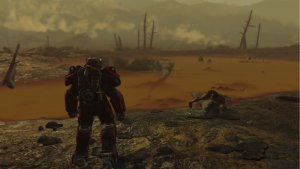
I personally wanted to break down the overall aesthetic of the game and several unique environments for the beginning of this review. For starters I would just like to point out my favorite environment in the entire game that is right above this paragraph. This location is called the Glowing Sea, it is basically a low-level players hell, but it provides players with a different perspective of the series’ game world. The Glowing Sea is the area that is in close proximity to the ground zero of the nuclear strike that devastated Boston. The environment is void of any kind of sustainable terrain or plant-life. The player has to venture through this radioactive hell in order to progress the story through a specific quest. During which the player will encounter some of the most disgusting and tough enemies in the entire game. This on top of being the single most radioactive place on the entire map excluding the two nuclear reactors you venture to during the game makes this journey tedious and difficult. The player is constantly being attacked while also taking radaway (a medicine that magically gets rid of radiation, HURRAH for REALISM!) in order to keep the amount of rads that are affecting their body at a low rate. It is next to impossible to walk through this area without radiation suit or power armor along with dozens of radaways on the higher difficulties. I personally fond this journey to a cave at the edge of the map, past this area, as the most memorable part of the entire game. The fear of nearly always being killed by mutated beasts or radiation combined with how long it takes to traverse this location adds to the overall feel of how futile your journey appears to be until you finally reach your destination.
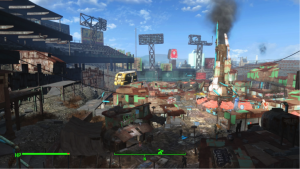
Another location Diamond City, which is a town constructed inside of Fenway Park, also proved to be a unique environment. I personally enjoyed seeing humanity attempt to rekindle what is left of society inside the ruined baseball stadium. Overall the game looks good, but not great. I have been running the game at 4K in 60 frames per second and I have been kind of underwhelmed. That being said I absolutely love the art direction and usage of such a wide variety of colors in the games palette. Unlike previous games such as Fallout 3 or Fallout New Vegas, Fallout 4 lacks the saturation that plagued 3 or the ugly sepia tone that made New Vegas seem straight out of Dust from Counter Strike Source. The textures at time, even on my PC were muddy at times, while at other points in the game I was caught off guard by the beauty of some in environments. For example, the previously mentioned area, The Glowing Sea was oddly beautiful, even though it was an absolute wasteland. I personally have yet to play the game on console, but the reports from IGN and Destructoid (which gave the game a 7.5/10) pointed out the low frame rate including drops to a pitiful 0 frames per second on the Xbox One. The game literally cannot run better than 30 frames per second on the Xbox One, and even so it hardly ever is at 30 frames to begin with. Sadly, the PS4 which by no means would get 60 frames per second was also handicapped by Bethesda’s decision to lock cap both consoles frame rates’ even though the PS4 would arguably have higher frame rate. Non the less, the only complaint I have for this entire game is its few graphical flaws, its inability to run steadily on console and its recycled animations which I will touch on later.

The weapons and armor in Fallout 4 are few when it comes to base models but make up for it by being modular and open to customization. The ability to change so many things about my favorite handgun that I customized in the game, a .44 magnum I named the Wild Wayne in game, made me honestly care about my gear and weapons. I always fond myself scavenging derelict buildings in search of materials that I could either use to upgrade my gear or my settlements. The latter of which is a new feature that allows the player to create small little villages that can house settlers and companion non-playable characters. I will not go into detail about this feature since it is actually optional when it comes to completing the game and holds only little value in the overall meta of the entire game. A positive side effect of having customization for the player’s gear allows for various play styles to be used in the game. I fond myself using the armor taken off of a secondary antagonist, a cyborg named Kellog, that I killed about 1/4th of the way through the game combined with my .44 magnum and silenced sniper rifle as a solid strategy for combating enemies in the wasteland. Of course some enemies require a more brute means of destruction, I am looking at you super mutants and death claws. In these specific encounters I decided to personally equip more “personal” weapons such as the semiautomatic shotgun above that holds 32 shotgun shells. When that specific weapon wouldn’t suffice I would always end up using my laser Gatling gun that I nicknamed “The Duke,” because it just sounded cool. I will not touch on the vast variety of armor sets that the you can find in this game just out of necessity for time. That being said some of the armor types are brutally effective at not only protecting your player but also being incredibly intimidating.
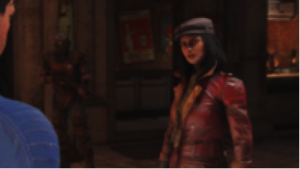
The writing and overall character design and voice acting is easily the best in the franchise (sorry Liam Neeson, you were pretty cool in Fallout 3 though). The witty reporter above, Piper, proved to be sarcastic and deadly with her words. Her trench coat attire and paperboy hat were just the final touches on a near perfect companion in a Fallout game. Back to the writing though, the Fallout games have never taken themselves this seriously. Topics ranging from if inhumane medical experiments are worth it for the greater good of the human race to are synthetic humanoids worthy of human rights are all tackled in this game. I attribute this more serious writing to the themes that are laid down in the beginning of the game. I am talking about the fact your husband or wife (depending on which gender you choose to play as) is killed in front of you and mysterious people take your son away from their dead body in the opening sequence of the game. This combined with the fact that your character actually lived in the world before the nuclear attacks, thanks to being cryogenically frozen in a vault right after the attacks. This gives the world a different perspective since you character constantly comments on how things were before the attacks and entertains or confuses other characters that never had the opportunity to live in a time before the bombs dropped. Ultimately the games main story begins as a journey to find the player’s son named Shaun. However, it soon becomes more complicated than that. For starters the player believes that their kid is only an infant when they finally wake up from their deep sleep. After which clues hint at your son being around 10 years old, which the player’s character accepts as the truth. Oh how gullible of the player’s personality to actually believe this.
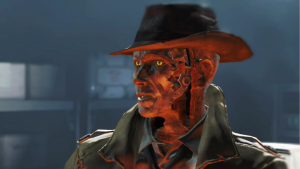
During this journey countless characters such as my favorite character above, the synthetic robot-hum detective, Nick Valentine, inform the player that a shadowy organization is up to no good. The organization, which calls itself the Institute is responsible for creating the synths, which are synthetic humanoid robots. These creations range from clearly being robots to resembling humans down to the exact detail. This is where the theme about are synthetic humanoids worthy of human rights, that I mentioned before comes into play. Nick, who is easily the most well written character in the game, is a proponent that synths are sentient and self aware, that they deserve to be treated as equals to humans. Other groups, such as the Brotherhood of Steel (you might recognize them from other games) believe that synths are a disgusting invention created by the Institute that are abominations to humanity. In addition to the creating the synths, the institute is fond to be responsible for taking your son. In fact your son’s DNA helped the institute create the synths since your son was a perfect specimen for a non-radiated human. This on top of the fact that the Institute is also harassing the “normal” humans from their subterranean base beneath CIT (once again a play on MIT) makes them at first appear to be the antagonists or at least the “bad guys.” However, after finally reaching the Institute the player realizes that the group isn’t exactly what you expected.
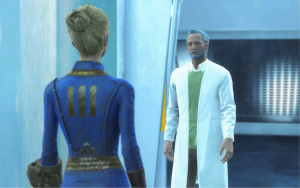
For starters, it turn out that the leader of the Institute is actually your son Shaun. He reveals that it has actually been 60 years since he was taken away from your spouse while the three of you were frozen in Vault 111. This explains why he is so old and is dying of cancer (cough spoiler). Shaun reveals to the player that the Institute has actually been striving to attempt to reverse some of the effects of the nuclear attacks on the environment and is actually working to preserve the human race. They created the synths to act as pseudo slaves or as he phrases it “custodians.” Regardless, if you believe in sentient beings having absolutely no free will and being controlled by literal masters (symbolism much, slavery? Containment?) then you may side with the idea that the synths deserve this treatment. I personally found myself playing through the game three times at first to experience all three options when it comes to how you as the player believes they should be treated. My first instinct was that I should side with the Institute because honestly, putting the whole slavery of sentient creations aside, the Institute was actually completing essential scientific work for the betterment of the human race. The second time I sided with the Brotherhood of Steel and obliterated all synths and destroyed the last haven for any chance of a future for the human race (bleak right?). This option is arguably the worst of the three because all synths are exiled or hunted down like animals and humanity is doomed due to the destruction of the research the Institute has spent 150+ years working on. The last option has the player side with the Railroad (I am aware you can side with several more factions but they have little impact on the synth issue). This group of scientist and thieves is attempting to learn about and collect the Institutes research while at the same time freeing synths because they believe they are equal to humans. From my own personal moral perspective I felt that this was the best decision. Although the Institute is destroyed, along with the Brotherhood of Steel’s Commonwealth chapter, the Railroad secures the Institutes research and synths are freed of their bonds to their masters. Regardless of which decision you choose as the player, your son dies due to sickness either the villain (if you side with the Brotherhood of Steel or the Railroad) or as an ally (if you sided with the Institute). Also I forgot to mention if you do not side with the Institute you plant a fusion bomb on their nuclear reactor and nuke a good chunk of Boston.

I know I glanced over a important part of the game, the perk system and VATS but honestly they are incredibly self-explanatory and are expected in an RPG. Not to mention the same exact system can be found in Fallout 3 and New Vegas. Overall I have enjoyed my time in Fallout 4, I know for a fact that I will spend plenty more time in the game. The game has its positive and negative factors such as how it looks and runs (the picture above isn’t from the game but actually a live action trailer). Nonetheless the game is a worthy addition to the franchise. Could it have been better? Absolutely, almost no games are perfect. If you have plenty of hours and the grades to spare some time in the Commonwealth, I highly recommend picking up Fallout 4.
Verdict: 9/10 on PC. 8.5/10 on Console.


